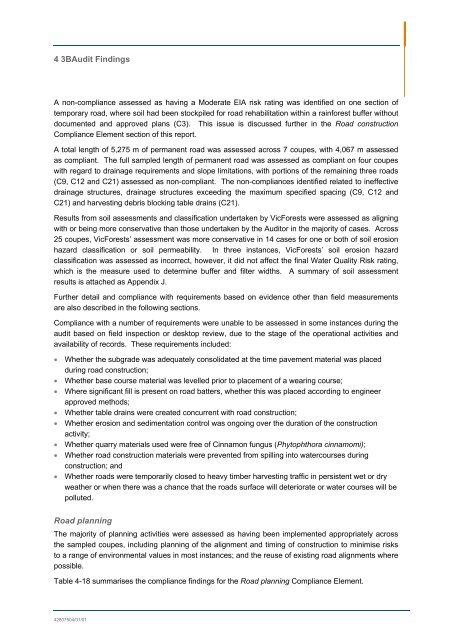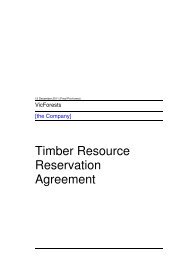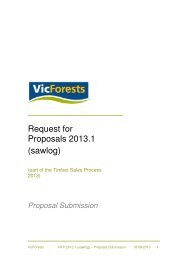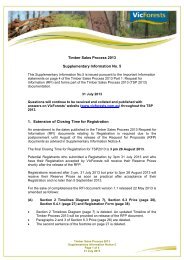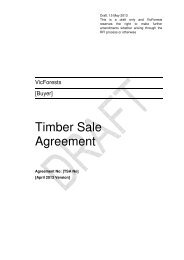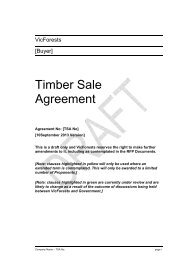Module 5 - VicForests
Module 5 - VicForests
Module 5 - VicForests
Create successful ePaper yourself
Turn your PDF publications into a flip-book with our unique Google optimized e-Paper software.
4 3BAudit Findings<br />
A non-compliance assessed as having a Moderate EIA risk rating was identified on one section of<br />
temporary road, where soil had been stockpiled for road rehabilitation within a rainforest buffer without<br />
documented and approved plans (C3). This issue is discussed further in the Road construction<br />
Compliance Element section of this report.<br />
A total length of 5,275 m of permanent road was assessed across 7 coupes, with 4,067 m assessed<br />
as compliant. The full sampled length of permanent road was assessed as compliant on four coupes<br />
with regard to drainage requirements and slope limitations, with portions of the remaining three roads<br />
(C9, C12 and C21) assessed as non-compliant. The non-compliances identified related to ineffective<br />
drainage structures, drainage structures exceeding the maximum specified spacing (C9, C12 and<br />
C21) and harvesting debris blocking table drains (C21).<br />
Results from soil assessments and classification undertaken by <strong>VicForests</strong> were assessed as aligning<br />
with or being more conservative than those undertaken by the Auditor in the majority of cases. Across<br />
25 coupes, <strong>VicForests</strong>’ assessment was more conservative in 14 cases for one or both of soil erosion<br />
hazard classification or soil permeability. In three instances, <strong>VicForests</strong>’ soil erosion hazard<br />
classification was assessed as incorrect, however, it did not affect the final Water Quality Risk rating,<br />
which is the measure used to determine buffer and filter widths. A summary of soil assessment<br />
results is attached as Appendix J.<br />
Further detail and compliance with requirements based on evidence other than field measurements<br />
are also described in the following sections.<br />
Compliance with a number of requirements were unable to be assessed in some instances during the<br />
audit based on field inspection or desktop review, due to the stage of the operational activities and<br />
availability of records. These requirements included:<br />
Whether the subgrade was adequately consolidated at the time pavement material was placed<br />
during road construction;<br />
Whether base course material was levelled prior to placement of a wearing course;<br />
Where significant fill is present on road batters, whether this was placed according to engineer<br />
approved methods;<br />
Whether table drains were created concurrent with road construction;<br />
Whether erosion and sedimentation control was ongoing over the duration of the construction<br />
activity;<br />
Whether quarry materials used were free of Cinnamon fungus (Phytophthora cinnamomi);<br />
Whether road construction materials were prevented from spilling into watercourses during<br />
construction; and<br />
Whether roads were temporarily closed to heavy timber harvesting traffic in persistent wet or dry<br />
weather or when there was a chance that the roads surface will deteriorate or water courses will be<br />
polluted.<br />
Road planning<br />
The majority of planning activities were assessed as having been implemented appropriately across<br />
the sampled coupes, including planning of the alignment and timing of construction to minimise risks<br />
to a range of environmental values in most instances; and the reuse of existing road alignments where<br />
possible.<br />
Table 4-18 summarises the compliance findings for the Road planning Compliance Element.<br />
42807504/01/01 39


